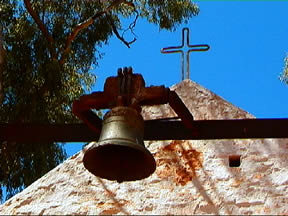
Introduction:
Albert
Namatjira, an Aboriginal of the Aranda tribe near the Red Centre,
was born in 1902 near the Hermannsburg Mission of Central Australia.
He learned to read and write at the Mission School and earned a
living on neighbouring cattle stations or as a handyman working
at the Mission. (It was common practice at the mission school, in
addition to receiving an education, Aboriginal boys were taught
a trade, i.e. blacksmithing skills, tanners, etc., while the girls
were taught the traditional work of the kitchen, quilting, sewing
blankets. Albert became a blacksmith by trade.
 |
In
1934 the artist Rex Battarbee held an exhibition of his watercoulours
at the Mission which deeply impressed Albert. On Battarbee’s
next trip to the Centre in 1936 arrangements were made for Albert
to act as his guide and camel boy on an eight-week bush tour. In
return for Albert’s work, Battarbee gave Albert lessons in
painting. In less than a month Albert was producing watercolour
paintings. He had a natural ability to draw and demonstrated the
drive and application of a true artist.
Albert’s
favourite subject to paint was the landscape around the Hermannsburg
Mission in the MacDonnell Ranges. It is vast, wild, and unbelievably
rugged and dry, with rivers of sand rather than water. This landscape
is filled with Aboriginal sacred sites, reflected in the landforms,
which Albert painted.
In 1938, the first exhibition of Albert’s
watercolours was held in Melbourne and was an immediate success.
He sold every painting on exhibit the first night of his exhibition!
In the 1940s, his work continued to gain popularity and was purchased
for exhibit in national art galleries in both Australia and New
Zealand.
Albert’s
style of watercolour painting reflected European styles of landscape
painting and was immensely popular. This popularity of his art among
non-Aboriginal people formed a bridge created between the two cultures.
Albert was recognized for his talent by being the first member of
his tribe to gain full Australian citizenship in 1957. Because of
this popularity, Albert was granted permission to own land, vote,
and buy ‘grog’ (alcohol). Previously, Aboriginals were
denied these rights enjoyed by the nonAboriginal people of Australia.
However,
these new freedoms given to Albert set him apart from other Aboriginal
people, which was difficult for him. Two years later at age 57,
he died after spending time in jail for purchasing alcohol, then
giving it to friends, which was against Australian law. He died
three months after being released. In the ten years following his
death, the rest of the Aboriginal population were granted citizenship,
due in part to Albert’s success as a painter.
During
his lifetime, Albert Namatjira experienced the best and worst of
both worlds, Aboriginal and European, but his paintings remain a
true celebration of his country.
How
does this story affect the art of Aboriginal people today? Aboriginal
art forms now express the traditional designs and patterns of this
ancient culture. Bark paintings and dot designs of the Dreamtime,
paintings of native animals, along with pottery, are examples. All
of these use the traditional dyes and ochres from the earth, and
are showcased in art galleries across the continent and the world.
The
importance of preserving traditional art forms is now realized.
Aboriginal children of today are encouraged to learn the skills
of their ancestors, helping to insure future generations maintain
a link to their colourful past.
Vocabulary:
- people's
rights
- traditional
- landscapes
- sacred
sites
- showcase
- ochres
Materials:
- watercolour
paper
- watercolours
- paintbrushes
Preparation:
- Research
a variety of the works of various artists that worked with watercolors.
- Identify
the techniques they used to create their work and the subjects
they chose to paint. Discuss why those subjects were choices for
watercolors, i.e., bodies of water, landforms and landscapes.
Procedure:
- Select
an object or a landscape to paint. Determine what characteristics
are important to portray in the painting, i.e., a particular tree,
mountain, body of water or identifying feature of the landscape.
- Experiment
with a variety of watercolours to achieve the desired effect of
the picture theme (salt crystals scattered over wet paint will
create a snowflake pattern on the paper).
- Create
a watercolour background for the picture, blending the watercolours
from all edges so that no white is showing. The actual landscape
design may use another form of medium as in construction paper
forms to project mountains, trees, objects, etc. Apply these after
the background is dry.
Analyze
and Conclude:
- How
did Albert Namatjira’s artwork benefit the Aboriginal people?
- What
was his predominant subject matter?
- Because
of the recognition his art received, he was the first Aboriginal
to be granted what by the Australian government?
- What
are some of the reasons for creating visual art? What can it achieve?
- Discuss
how art effects our lives. In student journals, describe why you
think Albert Namatjira’s success as a painter brought about
changes in citizenship and rights being given to the Aboriginal
people of Australia.
Management
Tip: use the print feature
in your browser to print this page.
|
